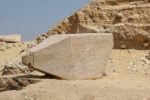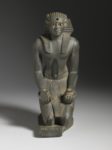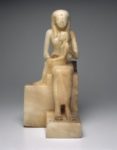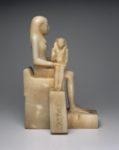 A joint French-Swiss archaeological mission has discovered the tip of an obelisk from the Old Kingdom in the necropolis of Saqqara. At more than eight feet in length, the red granite fragment is largest piece of an Old Kingdom obelisk ever found. Archaeologists estimate that the complete obelisk was around 16 feet high. A groove around the top of the obelisk, the pyramidion, indicates that it was originally capped with copper plates or gold foil so it could reflect the sun and shine brightly during the day.
A joint French-Swiss archaeological mission has discovered the tip of an obelisk from the Old Kingdom in the necropolis of Saqqara. At more than eight feet in length, the red granite fragment is largest piece of an Old Kingdom obelisk ever found. Archaeologists estimate that the complete obelisk was around 16 feet high. A groove around the top of the obelisk, the pyramidion, indicates that it was originally capped with copper plates or gold foil so it could reflect the sun and shine brightly during the day.
An incomplete inscription on one side of the obelisk identifies it as dedicated to 6th Dynasty Queen Ankhnespepy II (ca. 2350 B.C.), wife and mother of multiple pharaohs.
Mostafa Waziri, secretary-general of the Supreme Council of Antiquities, told Ahram Online that the artefact was found at the eastern side of the queen’s pyramid and funerary complex, which confirms that it was removed from its original location at the entrance of her funerary temple.
“Queens of the 6th dynasty usually had two small obelisks at the entrance to their funerary temple, but this obelisk was found a little far from the entrance of the complex of Ankhnespepy II,” Waziri pointed out, suggesting it may have been dragged away by stonecutters from a later period.
Most of the necropolis was used as a quarry during the New Kingdom and Late Period.
 Ankhesenpepy II was no stranger to powerful women. Her mother Nebet was the first female vizier in Egyptian history (that we know of, at least), appointed by Pharaoh Pepy I. There would not be a second woman to hold that position until the 26th Dynasty. Both of her daughters married and gave birth to pharaohs. Ankhesenpepy I and II married their mom’s boss Pepy I. After his death, Queen Ankhesenpepy II married her sister’s son Pharaoh Merenre Nemtyemsaf I, which is why she also went by Queen Ankhnesmeryre II. According to the South Saqqara Stone annals which record the reigns of Sixth Dynasty pharaohs, Merenre reigned for about a decade and was succeeded by his and Ankhesenpepy II’s son Pepy II.
Ankhesenpepy II was no stranger to powerful women. Her mother Nebet was the first female vizier in Egyptian history (that we know of, at least), appointed by Pharaoh Pepy I. There would not be a second woman to hold that position until the 26th Dynasty. Both of her daughters married and gave birth to pharaohs. Ankhesenpepy I and II married their mom’s boss Pepy I. After his death, Queen Ankhesenpepy II married her sister’s son Pharaoh Merenre Nemtyemsaf I, which is why she also went by Queen Ankhnesmeryre II. According to the South Saqqara Stone annals which record the reigns of Sixth Dynasty pharaohs, Merenre reigned for about a decade and was succeeded by his and Ankhesenpepy II’s son Pepy II.
 Pepy II was a young boy when he acceded the throne, no older than six, and it’s likely that his mother served as regent in the early years of what would become a very, very long reign (spanning at least seven decades and possibly as long as 88 years). A beautiful alabaster statue now in the Brooklyn Museum portrays them both as rulers. The mother, much larger than her boy king son, holds him in her lap. His small size and position on his mother’s lap indicate his youth, but they are formally posed, each looking forward in different directions, and he is adorned and titled with the ornaments of his office. He wears the nemes headdress with the cobra of a pharaoh, and an inscription under his feet declares him “King of Upper and Lower Egypt, Pepy II, beloved of the god Khnum, given all life, like Re, forever.” An inscription under Ankhesenpepy’s feet reads: “Mother of the King of Upper and Lower Egypt, the god’s daughter, the revered one, beloved of Khnum, Meryre-anhknes.”
Pepy II was a young boy when he acceded the throne, no older than six, and it’s likely that his mother served as regent in the early years of what would become a very, very long reign (spanning at least seven decades and possibly as long as 88 years). A beautiful alabaster statue now in the Brooklyn Museum portrays them both as rulers. The mother, much larger than her boy king son, holds him in her lap. His small size and position on his mother’s lap indicate his youth, but they are formally posed, each looking forward in different directions, and he is adorned and titled with the ornaments of his office. He wears the nemes headdress with the cobra of a pharaoh, and an inscription under his feet declares him “King of Upper and Lower Egypt, Pepy II, beloved of the god Khnum, given all life, like Re, forever.” An inscription under Ankhesenpepy’s feet reads: “Mother of the King of Upper and Lower Egypt, the god’s daughter, the revered one, beloved of Khnum, Meryre-anhknes.”
 A relief of Ankhesenpepy at the ancient site of Wadi Maghareh on the Sinai Peninsula depicts her as the same size as her adult son, a meaningful distinction in Egyptian art. While there are no explicit references to her regency in the archaeological record, this iconography and the realities of a six-year-old pharaoh strongly suggest she was the effective ruler until he came of age, and thereafter continued to hold an elevated place at her son’s court. The size of her funerary pyramid, built during Pepy II’s reign, also attests to her unique importance. It is second only to his in size.
A relief of Ankhesenpepy at the ancient site of Wadi Maghareh on the Sinai Peninsula depicts her as the same size as her adult son, a meaningful distinction in Egyptian art. While there are no explicit references to her regency in the archaeological record, this iconography and the realities of a six-year-old pharaoh strongly suggest she was the effective ruler until he came of age, and thereafter continued to hold an elevated place at her son’s court. The size of her funerary pyramid, built during Pepy II’s reign, also attests to her unique importance. It is second only to his in size.
“Most of the necropolis was used as a quarry during the New Kingdom and Late Period.”
Look on my Works, ye Mighty, ……
It makes you wonder what they used the quarried material for. Did the rest of the obelisk become a well-known statue, or so many second-rate burial goods, or long worn-away and broken up pavers?
There are some well constructed stone byres in Cumberland near Hadrian’s Wall. Uncoincidental I assume.
Totally ‘COWincidental’ 🐃 Moo!
Granite ‘first- and second-rate burial goods’ is probably a good guess, nonetheless, as to cut granite pavers with ancient means would possibly not pay off in Egypt. There is plenty of granite statues and ‘sarkophagoi’ in your egyptian museum of choice.
Thus, to reuse broken obelisks was seemingly not unheard of at all (as was the reuse of existing graves).